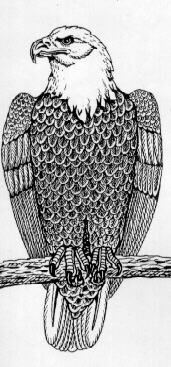
by: Pam Mills
FALL 1998
 It is estimated that there are well over 200 breeding pairs of bald eagles (Halia & eacute;etus leucoéphalus) in Nova Scotia, many of them concentrated around the Bras d'Or Lakes in Cape Breton. To gather information on the survival and movement of the birds, the Department of Lands and Forestry initiated a program of eaglet banding in the late 1970s. From 1977 to 1988, over 580 Cape Breton eaglets were banded in the nest. Last year, the carcasses of three of these, along with their bands, were recovered.
It is estimated that there are well over 200 breeding pairs of bald eagles (Halia & eacute;etus leucoéphalus) in Nova Scotia, many of them concentrated around the Bras d'Or Lakes in Cape Breton. To gather information on the survival and movement of the birds, the Department of Lands and Forestry initiated a program of eaglet banding in the late 1970s. From 1977 to 1988, over 580 Cape Breton eaglets were banded in the nest. Last year, the carcasses of three of these, along with their bands, were recovered.
The first eagle was found dead near Grand Narrows, Cape Breton County on April 21, 1997. The pathology department at the Atlantic Veterinary College in P.E.I. determined that the cause of death was possibly due to drowning or hypothermia. The adult female was in good body condition with no sign of traumatic injury or poisoning. It had been banded on June 25, 1979, at False Bay, Richmond County.
On May 7, 1997 the Department received a report from Arrowsic, Maine of an injured adult bald eagle. The bird was found under a power transmission line; its head was badly burned and its chest was filled with fluid indicating it had been electrocuted. These severe injuries meant that it had to be euthanised. This bird was originally banded on June 24, 1981 as a nestling in Inverness County.
Six days later, a 12 year old eagle was found near Kytes Hill, Cape Breton County. The cause of death is unknown since the bird had been dead for some time. It had been banded in the nest on June 12, 1985, at Jackson Lake, Cape Breton County.
Bald eagles have been known to live for over 25 years in the wild. However, these three birds were probably all around the average life span for wild eagles, which face a variety of threats like starvation, disease, and accidents. Information gathered from banding programs such as this help to increase our knowledge and understanding of wildlife, which in turn helps DNR to better manage Nova Scotia's wildlife populations.